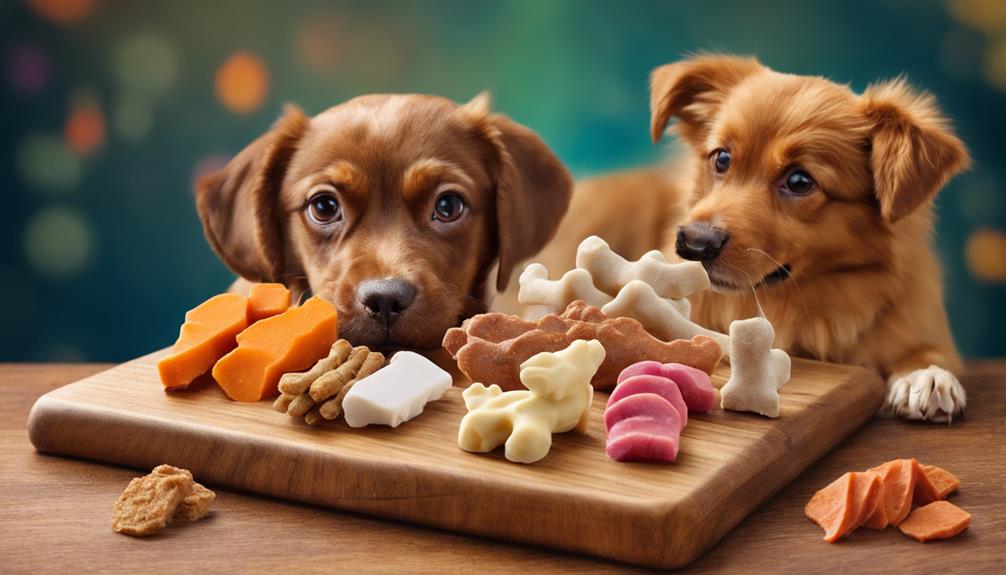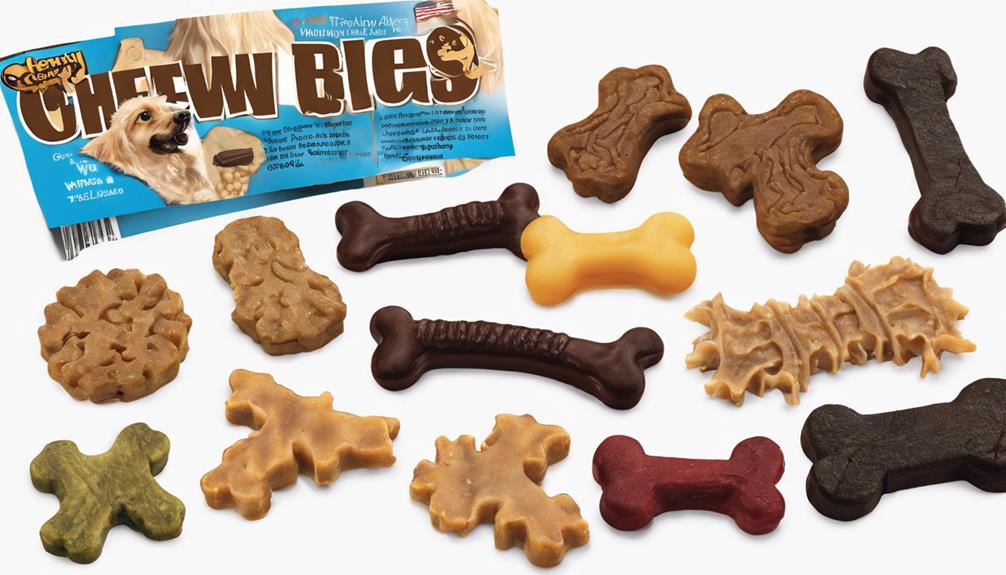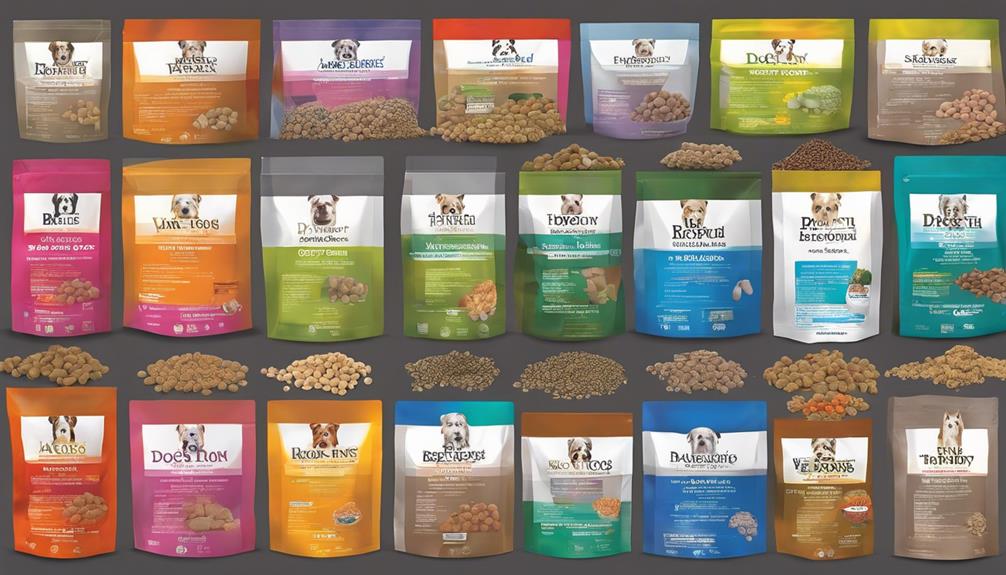When training your dog, choose healthy treats such as PureBites Chicken Breast Freeze-Dried Raw Dog Treats, Zuke’s Mini Naturals Peanut Butter & Oats Recipe Dog Treats, or Plato Small Bites Organic Chicken Dog Treats that are all under 3 calories. For puppies, Wellness Soft Puppy Bites or Fruitables Skinny Minis with salmon, lamb, carrots, and blueberries are excellent options. Consider high-value treats like Smelly moist options for effectively teaching new behaviors. Soft training treats with a chewy texture and less than 3 calories per piece provide a healthy reward.
Choose hard and crunchy treats that promote dental health for outdoor sessions. Remember, if you need more tips, continue exploring the various training treat options available for your furry friend!
Key Takeaways
- Choose low-calorie options under 3 calories for effective training without overfeeding.
- Opt for high-value treats with smelly and moist textures to maintain motivation.
- Consider soft treats made with real meat, peanut butter, or oats for healthy rewards.
- Select hard and crunchy treats to promote dental health and engagement during training.
- For dogs with sensitive stomachs, opt for hypoallergenic treats with limited ingredients to prevent reactions.
Low-Calorie Dog Training Treats
When training your dog, choose low-calorie treats like PureBites Chicken Breast Freeze-Dried Raw Dog Treats to keep their calorie intake in check. These treats are freeze-dried, ensuring a high-protein content while staying under 3 calories per treat.
For an equally appealing option, consider Essential Essentials Minnows Freeze-Dried Raw Dog Treats, which offer a smelly, high-protein reward with approximately 2 calories per treat.
If your furry friend prefers softer, chewier treats, Zuke's Mini Naturals Peanut Butter & Oats Recipe Dog Treats are a fantastic choice, providing a delicious snack with less than 3 calories each.
Plato Small Bites Organic Chicken Dog Treats are another excellent option, made with organic chicken and boasting less than 3 calories per treat.
Training Treats for Puppies

To continue your dog's training journey, consider the ideal training treats for puppies to maintain their interest and motivation. When choosing treats for your puppy, opt for options like Wellness Soft Puppy Bites and Fruitables Skinny Minis. Wellness Soft Puppy Bites are highly aromatic and made with wholesome ingredients such as salmon, lamb, carrots, and blueberries. On the other hand, Fruitables Skinny Minis come in various fruit flavors, are easy to break into smaller pieces, and contain only 3 calories each, making them suitable for puppies in training.
Here is a comparison table showcasing the key features of these training treats for puppies:
| Features | Wellness Soft Puppy Bites | Fruitables Skinny Minis |
|---|---|---|
| Ingredients | Salmon, lamb, carrots, blueberries | Fruity flavors |
| Calories | 3 calories each | 3 calories each |
| Texture | Soft and chewy | Chewy and easy to break apart |
| Smell | Highly aromatic | Smellier |
| Artificial Ingredients | Free from artificial colors, flavors, and meat by-products | No artificial ingredients, colors, or preservatives |
High-Value Training Treats
Consider incorporating high-value training treats into your dog's training regimen to enhance motivation and focus during pivotal learning moments. High-value treats are smelly and moist, making them irresistible to your furry friend. These special rewards are perfect for teaching new behaviors, reinforcing positive actions, and encouraging your dog to respond in unique ways during training sessions.
When dealing with distractions or trying to improve focus, high-value treats can make all the difference in your dog's learning progress. However, it's essential to select treats that aren't high in fat to prevent any stomach issues during training. Reserve these treats for specific instances where you need your dog to concentrate and perform exceptionally well.
By strategically using high-value treats as a form of positive reinforcement, you can effectively shape your dog's behavior and responses in various dog training scenarios.
- High-value treats are smelly and moist, making them rare outside of training sessions.
- These treats are ideal for teaching new behaviors, handling distractions, or encouraging special responses from your dog.
- Avoid high-fat foods in high-value treats to prevent stomach issues during training.
- Reserve high-value treats for specific situations where focus and performance are vital.
- Strategic use of high-value treats reinforces positive behaviors effectively during training sessions.
Soft Training Treats

Soft training treats, with their chewy texture and versatility for different training needs, are a favorite choice among dogs during training sessions. These treats, often less than 3 calories each, offer a healthy option for rewarding your furry friend. Made with high-quality ingredients such as real meat, peanut butter, or oats, soft training treats provide a delicious taste that dogs love. Additionally, they are free from artificial additives, ensuring a natural and healthy treat for your pet.
To help you understand the benefits of soft training treats better, take a look at the table below:
| Feature | Description |
|---|---|
| Chewy Texture | Ideal for dogs who prefer a chewy consistency during training sessions. |
| Real Meat | Made with real meat for a savory and satisfying flavor. |
| Calorie Conscious | Less than 3 calories per treat, suitable for calorie-conscious training. |
When choosing treats for your dog's training, opt for soft training treats with high-quality ingredients and a chewy texture to provide a healthy and natural reward.
Hard and Crunchy Training Treats
When looking to diversify your dog's training rewards, consider turning to hard and crunchy training treats for a satisfying texture and dental benefits. These treats are beneficial for your dog's dental health as they promote chewing, which helps reduce plaque buildup.
The satisfying crunch of these treats is favored by some dogs during training sessions. Hard treats like biscuits are perfect for outdoor training or longer sessions where a firmer texture is needed. Made with wholesome ingredients, these treats often contain valuable nutrients such as omega-3 fatty acids.
By incorporating hard and crunchy treats into your training routine, you can keep your dog engaged and excited to learn.
Here are some key points to keep in mind when using crunchy treats:
- Promote dental health through chewing.
- Provide a satisfying texture that dogs enjoy.
- Ideal for outdoor training or longer sessions.
- Made with wholesome ingredients.
- Keep your dog engaged during training.
Chewy Training Treats

For dogs who enjoy softer textures, chewy training treats provide a tasty and convenient option during training sessions. Chewy treats are easy to break into smaller pieces, allowing for portion control and quick consumption. Their soft and tender texture can be more appealing to dogs, making them ideal for puppies and older dogs with dental issues.
When choosing chewy training treats, opt for high-quality options made with real meat or protein to guarantee top-notch nutrition for your furry companion. These treats aren't only nutritious but also portable, making them perfect for on-the-go training sessions.
The combination of being tasty and packed with essential nutrients makes chewy training treats a great choice for rewarding your dog during training. Remember to take into account your dog's preferences and dietary needs when selecting the perfect chewy training treat to motivate and encourage good behavior.
Training Treats for Small Dogs

Training small dogs requires utilizing treats that are specially crafted for their size and dietary needs. When choosing training treats for small dog breeds, consider the following:
- Soft Treats: Opt for softer treats that are easy for small dogs to chew and swallow, making training sessions more enjoyable for them.
- Quick Consumption: Treats tailored for small breeds are often smaller in size, allowing for quick consumption during training without causing delays.
- Calorie Content: Pay attention to the calorie content of the treats to prevent overfeeding, as small dogs have specific dietary requirements.
- High-Quality Ingredients: Choose treats made with high-quality ingredients to make sure your small dog receives the necessary nutrients for top-notch training results.
- Chewy Treats: Soft, chewy treats can be more appealing to small dogs, motivating them to actively participate in training exercises.
Training Treats for Large Dogs

Consider selecting larger-sized training treats to cater to the needs of your big canine companions, guaranteeing they can handle and savor their rewards effectively during training sessions. Large dogs, such as Great Danes or Mastiffs, require treats that aren't only size-appropriate but also rich in protein content to support their muscle development.
Look for training treats specifically formulated for large breeds to ensure they meet the nutritional needs of your big furry friend. Opt for softer treats that are still substantial enough for large breeds to enjoy without presenting a choking hazard. Additionally, treats with added joint supplements or vitamins can be highly beneficial for the overall health and well-being of your large dog during training sessions.
Training Treats for Dogs With Sensitive Stomachs

When catering to dogs with sensitive stomachs, prioritize choosing hypoallergenic and easily digestible treats to avoid triggering any stomach issues. Here are some tips for selecting the best training treats for dogs with sensitive stomachs:
- Opt for Hypoallergenic Treats: Look for treats that are specifically labeled as hypoallergenic to minimize the risk of allergic reactions.
- Choose Easily Digestible Options: Select treats that are gentle on the stomach and easy to digest to prevent any gastrointestinal upset.
- Consider Treats with Limited Ingredients: Treats with fewer ingredients can help reduce the chances of triggering stomach sensitivities in your dog.
- Try Novel Proteins: Novel proteins like kangaroo, venison, or duck can be less likely to cause allergic reactions in sensitive dogs.
- Avoid Common Allergens: Steer clear of common allergens such as chicken, beef, or grains to prevent stomach issues in dogs with sensitive stomachs.
For specific recommendations tailored to your dog's needs, consult with a veterinarian who can provide expert guidance on suitable training treats for dogs with sensitive stomachs.
Bulk-Buy Training Treats

When looking to save money on training treats, buying in bulk is a smart choice. By purchasing larger quantities at a discounted rate per treat, you can stretch your budget further.
Remember to store these treats properly to maintain their freshness and quality over time.
Cost-Effective Training Treats
To save on training treat costs and always have a supply on hand, consider opting for bulk-buy training treats. Here are some reasons why bulk-buy training treats can be a cost-effective option for your training needs:
- Savings: Purchasing treats in larger quantities can result in savings per treat compared to smaller packages.
- Convenience: Bulk-buy options often come in resealable bags or containers, guaranteeing freshness and convenience.
- Variety: Some bulk-buy training treats offer different flavors or ingredient options to accommodate various preferences.
- Availability: Buying in bulk guarantees you always have training treats on hand, especially if you have multiple dogs.
- Cost-Effective: Bulk-buy training treats are a cost-effective solution for those who engage in frequent training sessions or have more than one dog to train.
Storage Tips for Treats
For peak freshness and longevity of your bulk-buy training treats, store them in a cool, dry place. Use a resealable container to guarantee spoilage prevention and maintain freshness.
Make sure to rotate your treats regularly, using older ones first to secure their freshness. Avoid storing treats in areas with direct sunlight or high humidity, as this can lead to mold growth.
Always check the expiration dates on your bulk-bought treats and discard any that have passed their recommended shelf life to safeguard your dog's safety. By following these storage tips, you can keep your training treats fresh and effective for your furry friend's learning sessions.
Frequently Asked Questions
What Are the Healthiest Training Treats for Dogs?
For the healthiest dog training treats, choose options high in protein, made with natural ingredients, and without artificial additives. Opt for low-calorie treats to prevent weight gain and consider grain-free choices for sensitive dogs.
What Do Professional Dog Trainers Use for Treats?
Professional dog trainers use high-value treats like real meat, cheese, or hotdogs to capture your dog's attention and maintain focus during training. Soft, easily chewable treats are preferred for quick consumption and positive reinforcement.
What to Avoid in Dog Training Treats?
When choosing dog training treats, avoid artificial colors, flavors, and preservatives. Steer clear of fillers like corn, soy, or wheat. Check for allergens, and skip treats with excessive fat or high sugar content. Prioritize your furry friend's health and well-being.
What Are Good High-Value Treats for Dogs?
To motivate your pup, opt for smelly, moist, rare treats like turkey hotdog or plain chicken. Avoid high-fat options. These special rewards reinforce new behaviors and beat distractions. They're key in challenging training scenarios.
Can the Healthy Dog Training Treats also be used as part of a balanced diet for my dog?
Yes, the best rated dog foods can also be used as healthy dog training treats. Look for options that are low in calorie and high in protein, like freeze-dried meat or small pieces of fresh veggies. Just be mindful of portion size and adjust your dog’s regular meals accordingly.
Can Healthy Dog Training Treats Help with Seizure Support for Pets?
When it comes to seizure support for pets, using the best dog foods for seizures can play a crucial role. Healthy dog training treats made with ingredients like CBD or Omega-3 fatty acids can also provide seizure relief and support for dogs. It’s important to consult with a veterinarian for the most suitable options.
Conclusion
As you begin your dog training journey, keep in mind that the snacks you choose play a vital role in your furry friend's success.
Just like a well-balanced meal nourishes your body, the right training snacks nourish your dog's mind and behavior.
So, choose wisely and invest in snacks that not only taste great but also help your dog learn and grow.
Your pup will thank you with tail wags and happy obedience!










